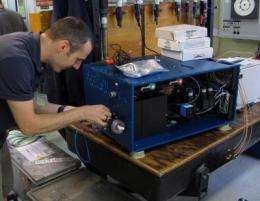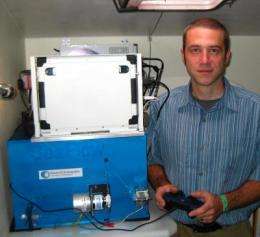Device reveals invisible world teeming with microscopic algae

It just got easier to pinpoint biological hot spots in the world's oceans where some inhabitants are smaller than, well, a pinpoint.
Microscopic algae are called phytoplankton and range from one to hundreds of microns in size – the smallest being 1/100th the size of a human hair. But as tiny as they may be, communities of the phytoplankton south of Vancouver Island, British Columbia, are big players when it comes to carbon: They take up 50 percent of the carbon dioxide going from the atmosphere into the oceans there.
"We thought that had to be a mistake at first," says Francois Ribalet, a UW post-doctoral researcher in oceanography and lead author of a Proceedings of the National Academy of Sciences paper on the discovery published online in September.
"They are such small cells to do so much," he says.
Phytoplankton, like plants on land, take up carbon from carbon dioxide during photosynthesis to build cells. Phytoplankton anchor the oceanic food web so where one finds a lot of phytoplankton, one usually finds a healthy collection of fish and animals. If not eaten, phytoplankton die and sink, carrying their carbon with them. Worldwide, ocean phytoplankton consume as much carbon dioxide as the Earth's forests and land plants combined.
"Being able to readily detect and track blooms of these small-celled phytoplankton is critical for understanding their impact in the oceans and global carbon cycle," Ribalet says.
SeaFlow, a device being developed at the UW, is making that task easier, he says. The instrument is a flow cytometer that measures the size and pigment composition of each single phytoplankton present in a sample at a rate of thousands of cells per second.

Typically biologists with traditional cytometers looked for phytoplankton using tablespoon-sized samples of water collected 10 to 50 miles or more from each other.
SeaFlow can sample seawater continuously making it possible to analyze samples every three minutes or two samples per mile traveled, says Jarred Swalwell, a research engineer with oceanography and lead developer. That's because the instrument taps into the system found on board most oceanographic research vessels that supplies running seawater to shipboard labs for such things as keeping specimens alive.
In this way SeaFlow collects more samples in a day than most scientists gather on an entire cruise, Swalwell says. And SeaFlow sensors and banks of computers, not scientists with traditional cytometers and microscopes, sort the characteristics of phytoplankton communities to determine what's present.
SeaFlow takes five minutes to do what used to take him two months, Ribalet says.
A prototype of the device revealed the biological hotspot off Vancouver Island and, for the first time, a marine ecotone, something oceanographers knew must exist but had no way to locate before now.

Ecotones are where different habitats overlap, where a prairie and forest meet, for example, or a river and estuary intersect. Ectones are rich with species because plants and animals from both ecosystems might be found there, as well as those adapted specifically to this hybrid environment. The ecotone discovered by Ribalet and colleagues is a 40-mile-wide region where ocean water rich with nitrates met coastal water rich with iron and where not just one, but five oceanic phytoplankton communities were detected taking full advantage of the carbon and nutrients concentrated there.
"This was just unexpected diversity," Ribalet says. "It flies in the face of the textbooks."
Ribalet and Swalwell imagine additional marine ecotones and biological hot spots could be detected if SeaFlows were installed on various ships and set up in a way to automatically alert scientists when phytoplankton abundance takes an interesting turn. Just such a SeaFlow set up has already been permanently mounted on the UW's vessel, the Thomas G. Thompson.
Provided by University of Washington
















